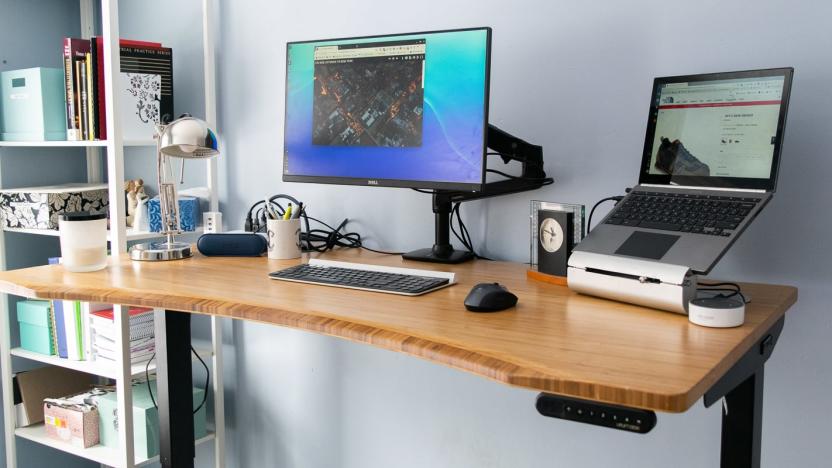standingdesks
Latest

The best standing desks
By Kevin Purdy This post was done in partnership with Wirecutter. When readers choose to buy Wirecutter's independently chosen editorial picks, Wirecutter and Engadget may earn affiliate commission. Read the full standing desks guide here. After two months of unboxing, building, using, testing, and comparing eight of the newest standing desks side by side, we think the Uplift Bamboo Stand Up Desk with 1" Thick Desktop and V2 Frame is the best desk for people who want a relatively stable surface that looks good, moves quickly and quietly, and should give you the fewest problems in working every day. But several other standing desks are nearly as good, and a few are worth considering. The Uplift bamboo desktop was every tester's favorite, particularly the (optional) ergonomic groove cutout in front. You can kit out the Uplift with a number of accessories that match your desk style, including power and cable organizers. It wasn't the best at everything, but the Uplift had the best mix of performance and features, and a lack of glaring flaws, of all the desks we tested. Just make sure you get the V2 frame (Uplift still sells the earlier model, which is a bit less stable). Though the Uplift is not the most rock-solid standing desk we tested this time, it's more stable than the desks we've recommended (and used happily) for years. The desks that were more stable had other flaws, like loud motors or ugly laminate tops. If you want to buy a standing-desk mat and monitor arm at the same time, you should consider the Fully Jarvis Bamboo Standing Desk, because it is a good standing desk that offers those extras in a package deal. The Jarvis was our top pick for more than four years, and is still a desk we recommend. The latest version of the Uplift frame and desktop felt more stable, particularly front-to-back, than the latest Jarvis frame when we tested both in late 2018. But the difference is not enormous; standing-desk stability is hard to measure precisely, and a half-dozen Wirecutter staffers have used Jarvis desks daily for years. The Jarvis's ¾-inch-thick bamboo desktop is thinner than the Uplift's 1-inch top, and looks lighter; otherwise they're nearly identical. In addition to the mat and monitor arm, Fully sells furniture and desk add-ons that mesh well with the Jarvis's look that you can purchase at a discount while ordering the desk, while the Uplift offers small upgrades, like powered grommets and privacy shields. The Varidesk ProDesk 60 Electric is more stable in each direction than the Uplift or Jarvis, and a little bit quieter than those desks in raising and lowering (minus an occasional thudding sound when starting). It also comes with built-in cable management, and was the easiest desk we've ever built. But it has no wood or bamboo desktop options, just five colors of laminate, which our testers disliked. If desktop style is not a high priority for you, and you'd rather pay a few hundred dollars more to have a more stable, quieter desk with easier assembly, the ProDesk 60 Electric could work for you—but we recommend the white or black finishes rather than the faux wood. It was a close call for many of the full-size electric standing desks we tested; several were near picks, except for flaws that will be dealbreakers for some people. Check out our impressions in the Competition section for more. If you're interested in adding a standing adapter to your existing desk, we are researching and testing standing desk converters for a separate review. For now, we still recommend the Kangaroo Pro Junior by Ergo Desktop, which has been our converter pick for four years. It provides a decently smooth and low-effort transition from sitting to standing, it keeps your monitor, mouse, and keyboard more stable than most desktop units we tested, and it doesn't require a very deep desk, or render a big chunk of your desk space unusable except for computer work.